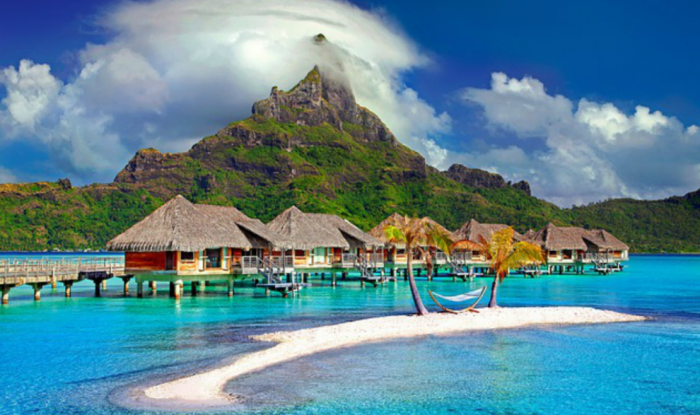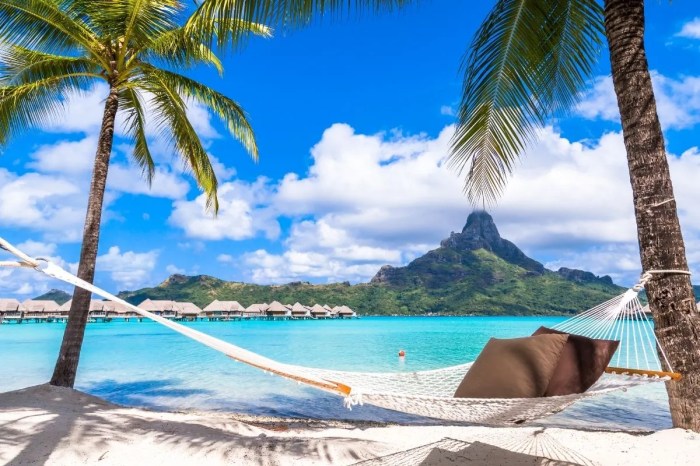Exotic Places To Vacation: The very phrase conjures images of sun-drenched beaches, snow-capped mountains, and vibrant cultures far removed from the everyday. But what constitutes “exotic”? This journey explores diverse interpretations of this term, delving into geographical regions boasting unparalleled beauty, thrilling adventure activities, and rich cultural immersion opportunities. From budget-friendly escapes to luxurious getaways, we uncover the planning essentials and responsible travel practices crucial for a truly unforgettable experience.
We’ll examine the varying perceptions of exotic destinations, influenced by individual experiences and cultural backgrounds. The exploration encompasses breathtaking landscapes, unique climates, and the importance of respecting local traditions. The impact of tourism on these delicate ecosystems will also be addressed, alongside strategies for sustainable travel and minimizing environmental footprints. Ultimately, this guide aims to equip you with the knowledge and inspiration to plan your own extraordinary adventure.
Geographical Regions
Exotic vacations beckon travelers to immerse themselves in diverse landscapes, climates, and cultures. Understanding the geographical distribution of these unique experiences is key to planning an unforgettable trip. This section examines five distinct regions renowned for their exotic vacation offerings.
Southeast Asia
Southeast Asia encompasses a vibrant tapestry of countries, each boasting unique attractions. The region’s tropical climate fosters lush rainforests, stunning beaches, and dramatic karst landscapes. Thailand, for example, is known for its opulent temples, bustling markets, and pristine islands. Vietnam offers breathtaking rice paddies, ancient cities, and vibrant coastal areas. Indonesia, a vast archipelago, showcases diverse ecosystems, from volcanic peaks to coral reefs, each island possessing its own distinct culture.
The region’s cultural diversity is equally compelling, with a blend of ancient traditions, colonial influences, and modern dynamism.
South America
South America’s diverse geography ranges from the towering Andes Mountains to the Amazon rainforest, the world’s largest tropical rainforest. The climate varies dramatically across the continent, from arid deserts to humid jungles. Peru, famous for Machu Picchu, the lost city of the Incas, offers a blend of ancient history and breathtaking mountain scenery. Brazil, home to the Amazon, provides opportunities for exploring the rainforest’s incredible biodiversity.
Argentina’s Patagonia region showcases stunning glaciers, rugged mountains, and vast plains. The cultural richness of the region is equally diverse, reflecting indigenous traditions, colonial legacies, and modern influences.
Sub-Saharan Africa, Exotic Places To Vacation
Sub-Saharan Africa is a continent of extraordinary contrasts, featuring vast savannas teeming with wildlife, lush rainforests, and dramatic deserts. The climate is predominantly tropical, although it varies significantly depending on altitude and proximity to the equator. Kenya and Tanzania are famous for their incredible wildlife safaris, offering opportunities to witness the Great Migration and observe iconic animals such as lions, elephants, and giraffes.
South Africa boasts diverse landscapes, from the Cape Winelands to the dramatic Table Mountain. Madagascar, an island off the coast of Africa, is known for its unique biodiversity, including lemurs and other endemic species. The cultural tapestry of the region is rich and diverse, with a multitude of languages, traditions, and artistic expressions.
The Caribbean
The Caribbean islands offer a paradise of pristine beaches, turquoise waters, and lush tropical vegetation. The warm, tropical climate is ideal for sunbathing, swimming, and water sports. Islands such as Jamaica, known for its reggae music and vibrant culture, offer a mix of relaxation and adventure. The Bahamas, with its stunning coral reefs and clear waters, is perfect for snorkeling and diving.
Cuba, with its rich history and unique culture, provides a fascinating blend of old-world charm and modern vibrancy. The diverse cultures of the Caribbean are a reflection of its history, with influences from Europe, Africa, and indigenous populations.
South Pacific
The South Pacific islands are renowned for their breathtaking beauty, idyllic beaches, and vibrant coral reefs. The tropical climate is consistently warm and humid, creating a perfect environment for relaxation and water sports. Fiji, known for its friendly people and stunning resorts, offers a luxurious escape. Tahiti, with its iconic overwater bungalows, provides an unforgettable romantic getaway.
The Cook Islands offer a secluded and tranquil setting, perfect for those seeking peace and quiet. The region’s cultures are rich and diverse, with a strong emphasis on community and tradition.
| Region | Key Attractions | Climate | Culture |
|---|---|---|---|
| Southeast Asia | Temples, beaches, rainforests, bustling markets | Tropical | Diverse blend of ancient traditions and modern influences |
| South America | Andes Mountains, Amazon rainforest, Machu Picchu | Varies greatly by region | Indigenous traditions, colonial legacies, modern influences |
| Sub-Saharan Africa | Wildlife safaris, savannas, rainforests, deserts | Tropical | Rich and diverse, with multitude of languages and traditions |
| Caribbean | Pristine beaches, turquoise waters, coral reefs | Tropical | Blend of European, African, and indigenous influences |
| South Pacific | Idyllic beaches, coral reefs, overwater bungalows | Tropical | Strong emphasis on community and tradition |
Adventure Activities
Exotic locales offer a plethora of thrilling adventure activities, catering to a wide spectrum of preferences and fitness levels. From adrenaline-pumping extreme sports to gentler explorations of nature, the possibilities are virtually limitless, promising unforgettable experiences for intrepid travelers. Careful planning and awareness of personal limitations are crucial for a safe and enjoyable adventure.
Adventure Activities by Fitness Level and Preference
The selection of an appropriate adventure activity hinges significantly on the individual’s fitness level and personal preferences. A physically demanding activity might be ideal for seasoned athletes, while a more relaxed experience might suit those seeking a less strenuous adventure. Matching the activity to individual capabilities ensures a positive and safe experience.
- High Fitness Level: Activities such as mountaineering in the Himalayas, white-water rafting in the Colorado River, or paragliding in the Swiss Alps demand significant physical endurance and stamina. These experiences often involve extended periods of exertion and exposure to challenging environmental conditions.
- Moderate Fitness Level: Options like hiking in national parks (e.g., exploring the Inca Trail to Machu Picchu), canyoning in the Verdon Gorge, or sea kayaking along the coast of Croatia provide a good balance of physical activity and scenic beauty. These activities require a reasonable level of fitness but are generally less demanding than high-intensity options.
- Low Fitness Level: Gentle activities such as hot air ballooning over Cappadocia, guided nature walks in Costa Rica’s rainforests, or exploring ancient ruins like Angkor Wat in Cambodia are suitable for individuals with lower fitness levels. These experiences prioritize exploration and cultural immersion over strenuous physical activity.
Adventure Activities by Risk Level and Required Equipment
Categorizing adventure activities based on inherent risk and necessary equipment allows travelers to make informed decisions aligned with their comfort levels and preparedness. Understanding these factors is paramount for safety and enjoyment.
| Risk Level | Activity Examples | Required Equipment |
|---|---|---|
| High | Mountaineering, Rock Climbing, Bungee Jumping | Specialized climbing gear (ropes, harnesses, carabiners), safety equipment (helmets, protective padding), experienced guides |
| Medium | White-water rafting, Hiking, Caving | Appropriate clothing and footwear, life vests (for rafting), headlamps (for caving), maps and compasses |
| Low | Hot air ballooning, Zip-lining, Guided nature walks | Minimal specialized equipment; often provided by tour operators. Comfortable clothing and footwear are recommended. |
Cultural Immersion

Respecting local customs and traditions is paramount when venturing into exotic locales. A successful and enriching travel experience hinges on understanding and appreciating the cultural nuances of the destination, fostering positive interactions with local communities, and contributing to responsible tourism. Failure to do so can lead to misunderstandings, offense, and ultimately, a less fulfilling journey.Engaging respectfully with local cultures involves a multifaceted approach.
It transcends simply avoiding obvious faux pas; it requires a genuine effort to understand the underlying values and beliefs that shape the community’s behavior. This understanding should guide interactions, ensuring that actions and attitudes are sensitive and considerate.
Methods for Respectful Cultural Engagement
Prior to departure, thorough research is essential. Learning basic phrases in the local language demonstrates respect and facilitates communication. Understanding local etiquette, including appropriate dress codes, dining customs, and social interactions, prevents unintentional offense. For instance, in many Southeast Asian countries, showing the soles of one’s feet is considered disrespectful. Similarly, in some cultures, direct eye contact can be perceived as aggressive.
Familiarizing oneself with these nuances beforehand ensures a smoother and more positive interaction.
Examples of Meaningful Cultural Interactions
Participating in local festivals and ceremonies provides immersive cultural experiences. Attending a traditional dance performance in Bali, for example, offers a glimpse into the rich artistic heritage of the island, while engaging with local artisans in a Guatemalan village provides insights into their craft and traditions. These interactions create opportunities for genuine connection and cultural exchange, contributing to a deeper understanding and appreciation of the local community.
Supporting local businesses, such as choosing family-run restaurants over international chains, and purchasing souvenirs directly from artisans, directly benefits the community and fosters a sense of mutual respect. Participating in community-based tourism initiatives, such as volunteering at a local school or helping with environmental conservation projects, provides a more meaningful and impactful travel experience, while also contributing positively to the local community.
Visual Representation: Exotic Places To Vacation

The visual appeal of exotic locations transcends mere aesthetics; it’s a potent cocktail of color, texture, and landscape that profoundly impacts the sensory experience, ultimately defining the “exotic” feeling. This section will explore three distinct destinations, highlighting their unique visual characteristics and the resulting sensory immersion.
The Vibrant Hues of the Cinque Terre, Italy
The Cinque Terre, a string of five picturesque villages clinging to the rugged Italian Riviera coastline, presents a visual feast dominated by intense, saturated colors. The pastel-hued houses, stacked against the steep hillsides, are punctuated by the deep greens of terraced vineyards and olive groves. The turquoise waters of the Ligurian Sea provide a stark contrast, creating a vibrant tapestry of color that shifts with the changing light.
The textures are equally diverse: the rough, weathered stone of the buildings, the soft, yielding earth of the vineyards, and the smooth, cool surface of the sea. The sensory experience is equally rich. The air carries the scent of salt, herbs, and sun-baked earth. The sounds of the waves crashing against the rocks, the chatter of locals, and the distant calls of seabirds create a lively soundscape.
The taste of fresh seafood, local wines, and pesto-laden pasta further enhance the sensory immersion, solidifying the destination’s exotic allure.
The Mystical Landscapes of Cappadocia, Turkey
Cappadocia offers a drastically different, yet equally compelling, visual experience. Its otherworldly landscapes are characterized by surreal rock formations—fairy chimneys—carved by wind and water erosion over millennia. The palette is dominated by muted earth tones: ochre, beige, and terracotta, punctuated by the occasional splash of green vegetation clinging to the rocky slopes. The textures are rough and varied, from the smooth, almost sculpted surfaces of the fairy chimneys to the coarse, sandy texture of the surrounding plains.
The sensory experience is one of quiet awe. The air is often still and dry, carrying the faint scent of dust and distant woodsmoke. The sounds are muted—the occasional bleating of sheep, the whisper of the wind—allowing the visual spectacle to dominate. The tastes of local delicacies, like pottery kebab cooked in traditional ovens, add a unique culinary dimension to the overall exotic feel.
The Lush Greenery of the Amazon Rainforest, Brazil
The Amazon Rainforest presents a visual spectacle of overwhelming abundance and vibrant life. The dominant colors are the intense greens of countless plant species, varying in shade from the deepest emerald to the palest lime. The textures are equally diverse, from the smooth bark of giant trees to the rough, tangled undergrowth. The sensory experience is intense and overwhelming.
The air is thick with humidity and the scent of damp earth, decaying leaves, and a myriad of exotic flowers. The sounds are a cacophony of life—the calls of exotic birds, the chirping of insects, the rustling of leaves—creating a vibrant and immersive soundscape. The taste of exotic fruits, like acai and guava, adds a unique culinary dimension to the experience, further emphasizing the region’s exotic character.
The sheer scale and density of the rainforest contribute significantly to its otherworldly quality.
Ultimately, the allure of exotic vacations lies in their ability to broaden perspectives, challenge preconceptions, and create memories that last a lifetime. By understanding the diverse definitions of “exotic,” respecting local cultures, and embracing sustainable practices, travelers can ensure that their adventures leave a positive impact on both the environment and the communities they visit. The journey to discover these hidden gems is as rewarding as the destinations themselves, promising a transformative experience that extends far beyond the typical vacation.

